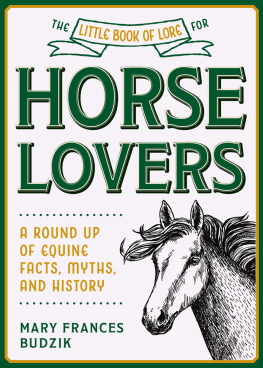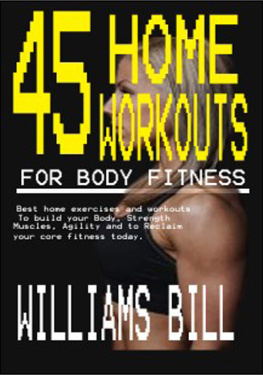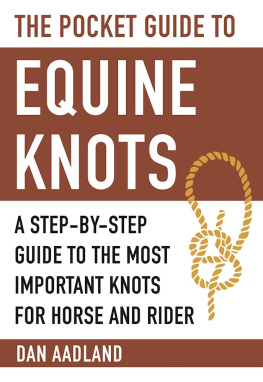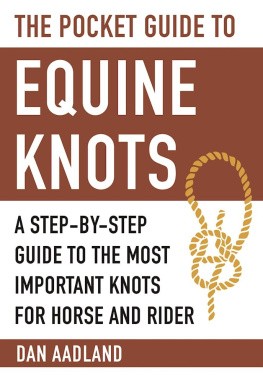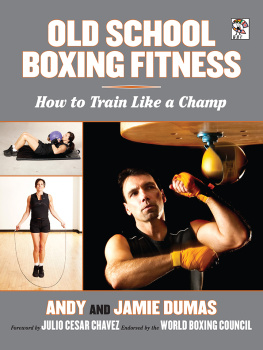Equine Fitness
Equine Fitness
A CONDITIONING PROGRAM
of Exercises & Routines for Your Horse
JEC ARISTOTLE BALLOU

The mission of Storey Publishing is to serve our customers by
publishing practical information that encourages
personal independence in harmony with the environment.
Edited by Lisa Hiley and Deborah Burns
Cover design by Alethea Morrison
Art direction and text design by Cynthia N. McFarland
Text production by Cynthia N. McFarland and Jennifer Jepson Smith
Illustrations by Jo Anna Rissanen
Arena diagrams by Ilona Sherratt
Indexed by Nancy D. Wood
2009 by Jec Aristotle Ballou
All rights reserved. No part of this book may be reproduced without written permission from the publisher, except by a reviewer who may quote brief passages or reproduce illustrations in a review with appropriate credits; nor may any part of this book be reproduced, stored in a retrieval system, or transmitted in any form or by any means electronic, mechanical, photocopying, recording, or other without written permission from the publisher.
The information in this book is true and complete to the best of our knowledge. All recommendations are made without guarantee on the part of the author or Storey Publishing. The author and publisher disclaim any liability in connection with the use of this information.
Storey books are available for special premium and promotional uses and for customized editions. For further information, please call 1-800-793-9396.
Storey Publishing
210 MASS MoCA Way
North Adams, MA 01247
www.storey.com
Printed in the United States by Versa Press
10 9 8 7 6 5 4 3 2 1
LIBRARY OF CONGRESS CATALOGING-IN-PUBLICATION DATA
Ballou, Jec Aristotle.
Equine fitness / Jec Aristotle Ballou.
p. cm.
Includes bibliographical references and index.
ISBN 978-1-60342-463-9 (pbk. : alk. paper)
1. HorsesHealth. 2. HorsesExercise. I. Title.
SF285.3.B35 2010
636.1'0893dc22
2009023864
Dedication & Acknowledgments
My most heartfelt gratitude goes to the numerous horses along the way that have taught me new ways to see things or given a little extra in their effort. Its these kinds of horses that make a trainer always want to increase the scope of her abilities. Through them, I have been able to keep raising the bar on equine athletic performance and I am thankful for this. Specifically, thanks to Catamacs Cat, a mare to whom my debt will never be repaid!
My second nod of gratitude goes to my teachers both here and abroad. Their patience and perseverance in the selfless act of teaching have often fueled my enthusiasm to continue working with horses and riders. I especially thank Manolo Mendez for always advocating the horses best interests. Thanks also to Dr. Sherry Ackerman, W. Charles Ballou, and the community of exceptional horsemen and horsewomen I grew up with at the Green Mountain Horse Association in Woodstock, Vermont. Many have gone on to represent the United States in international competitions; I am in awe of their humble roots.
Lastly, I would like to acknowledge my colleagues and clients who work tirelessly on the horses behalf. Thanks to Mark Schuerman, Naomi Johnston, Rachel Anicetti, David Lichman, Home At Last Sanctuary, Katherine Curran, and Storey Publishing.

CONTENTS

INTRODUCTION
M Y INTEREST IN PROPERLY CONDITIONING horses for their respective disciplines has developed over the years not only from riding and loving these animals but also from being an athlete myself. When you commit yourself, your horse, or both to a training plan, you soon realize how many unexpected bumps there are in the road. Even the best-laid plans can unravel. You may find yourself hitting a plateau in training, wondering why you are not advancing or why your horse seems sore or sour. This book will help you assess your progress and find the answers to many training questions and problems.
Having won championships in basketball, rowing, and mountain biking, as well as several equestrian disciplines, I have come to appreciate the straightforward but painstaking effort that goes into preparing an athlete to perform at his or her highest level. It matters not whether the event in question is a local fund-raiser or an international competition. What matters is that the athlete can perform in peak condition, with a happy attitude, and recover well, which means no prolonged period of soreness.
In my lifetime with horses, I have observed that the equine industry has become compartmentalized, with trainers and horses focusing exclusively on single disciplines. Daily workouts primarily address exercises or maneuvers specific to that discipline, to the detriment of focused and sustained time spent on overall equine fitness requirements. This situation is similar to a human gymnast practicing handsprings and splits repetitiously, day after day, but losing sight of the larger picture that he needs to consider, which is his ongoing basic fitness, beyond the particular demands of his chosen sport.
When overly specific training techniques are used with horses, the rider or trainer may determine that the horse is not making progress and diagnose the problem as a schooling shortfall. Much of the time, however, the issue is not necessarily one of inadequate schooling; it is more a matter of insufficient basic fitness, whether the problem is strength, coordination, or suppleness.
Maintaining your horses physical structure and cardiovascular aptitude (including stamina, recovery, and adaptability to stress) to the best of your ability will keep him happily and comfortably performing his job at the highest level. This is just as (if not more) important as undertaking an adequate amount of specialized training to meet the requirements of your chosen discipline. In many cases, addressing your horses underlying fitness can resolve many of the frustrating stumbling blocks that crop up along the way during any well-laid training plan. Be aware that even with the best schooling and conditioning plans, other factors such as boarding conditions and nutrition also affect your horses health and fitness.
KEY POINT
Training horses should always follow this equation: 50 percent of time spent on schooling; 50 percent of time spent on conditioning. Schooling should never outweigh work on basic conditioning.
Structuring Your Horses Daily Life
Most of us do not have the luxury of keeping our horses on our own property, which necessitates boarding them at commercial facilities. Any boarding situation comes with pluses and minuses. The main point to keep in mind when choosing a boarding facility is that your horses daily living conditions impact his overall well-being as much as the most well-intentioned training and conditioning plan.
Many owners make decisions about boarding based on budget or convenience. Within those constraints, I always emphasize to my students that it is crucial to put the horses needs above all else when choosing where to house him. In the end, this will make your life with him much easier. For instance, a horse who eats insufficient hay, lives in a cramped stall, and is surrounded by a stressful environment will go only so far in his career, even with the worlds best training. Daily handling, a regular feeding routine, access to turnout, and the opportunity to socialize are part of the equation that keeps a horse mentally and physically prepared for his job. They are
Next page


